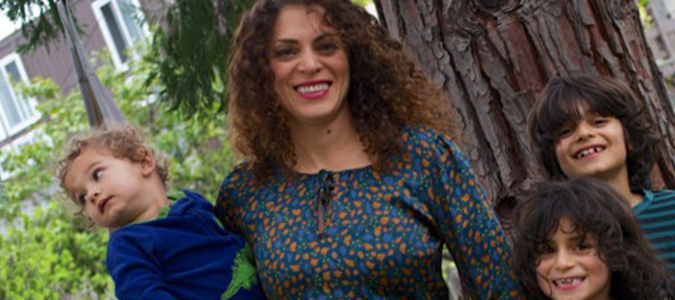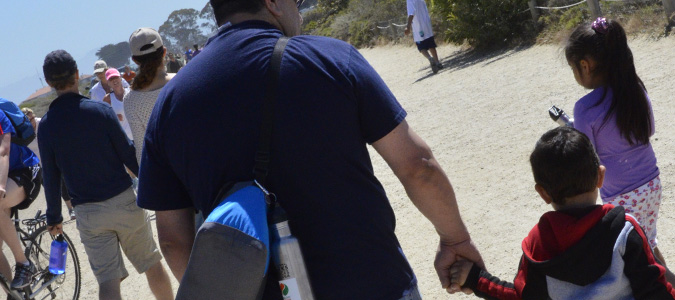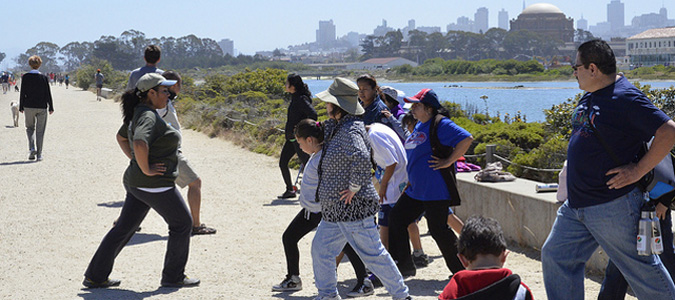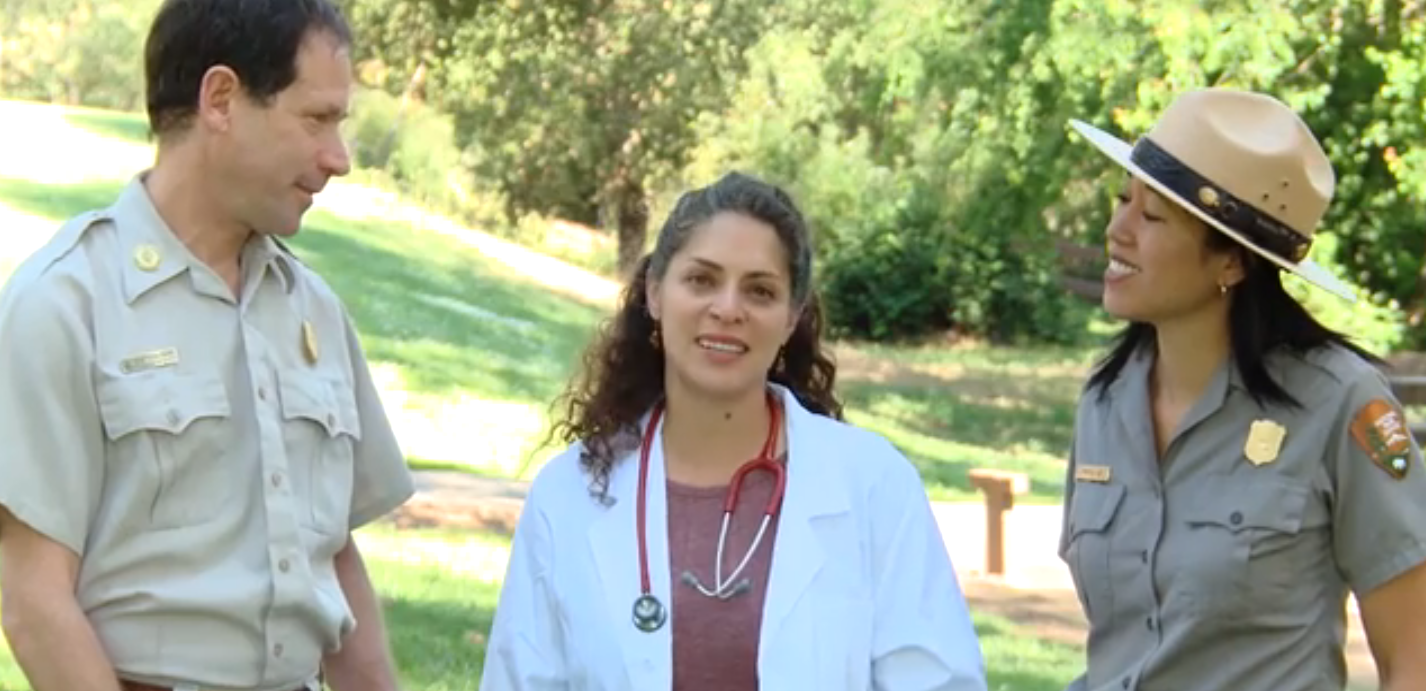 Nooshin Razani is a pediatrician at Children’s Hospital & Research Center in Oakland and a Senior Fellow at the Institute at the Golden Gate in San Francisco. She is the mother of three young children, with close extended family relationships. Nooshin is a leader and activist, advocating for access to nature for families with highest health needs. What is quickly apparent, is Nooshin’s deep love of nature and playful spirit.
Nooshin Razani is a pediatrician at Children’s Hospital & Research Center in Oakland and a Senior Fellow at the Institute at the Golden Gate in San Francisco. She is the mother of three young children, with close extended family relationships. Nooshin is a leader and activist, advocating for access to nature for families with highest health needs. What is quickly apparent, is Nooshin’s deep love of nature and playful spirit.
MR: Let’s begin with talking about your childhood memories of play and nature.
NR: For me, play is not a memory – it is part of my current life. And nature is the common ground for my different communities and one of my deepest relationships. I am a first generation Iranian-American, born and raised in Los Angeles with several of my preschool years and many summers spent in Iran. Both cultures were full of nature and play and full of beautiful communities – loud, optimistic, and loving cousins and picnics in the mountains in Iran, and vibrant and loving friends and the beach in Los Angeles. It was difficult for me to have these worlds separated because of revolution and politics, but the ocean, moon, and sky kept me grounded.
In fifth grade my elementary school in Los Angeles raised money and went on a one-week trip to Yosemite. I remember this week in Yosemite clearly and can compare the experience only to falling in love. There was an inner silence and confidence I experienced around beauty at such a grand scale.
During a presentation on Mono Lake, I felt a very mature anger and sorrow when I learned how human behavior impacts wilderness. I wrote a journal entry promising to not forget my commitment to the natural world when I grew up. I was nine then.
“I am a first generation Iranian-American, born and raised in Los Angeles with several of my preschool years and many summers in Iran. Both cultures were full of nature and play and full of beautiful communities – loud, optimistic, and loving cousins and picnics in the mountains in Iran, and vibrant and loving friends and the beach in Los Angeles.”
Throughout middle school and high school, my school had annual week-long trips in nature. Our teachers expressed a love and commitment to the natural world. While they were straightforward about what was happening, they never made me feel the situation was hopeless. These early experiences provided a reservoir, a relationship with nature that helped sustain me through some of the traumas in life.
As an adult I’ve started learning more about my culture and the stories behind our holidays. As it turns out, Persian rituals mark the natural rhythms of changing seasons and agriculture – almost every month and every season my community is noticing and celebrating nature. I’ve begun to appreciate the sorrow I felt and it seems many people are now feeling, as they lose the rituals and connection to stories of their ancestors. Getting kids into nature seems to me a pro-active way to define the new, global, multinational culture we all seek, while learning from generations past.
MR: Medical school can be very challenging – just how did you do it and keep connected to your playful nature?
NR: Medical school was very intense but I had a strong community of people around me and also participated in lots of dance. I have really fond memories. One of the things I also did was a Masters in Public Health – and that is probably what I am drawing on for all the projects that I do now.
“Getting kids into nature seems to me a pro-active way to define the new, global, multinational culture we all seek, while learning from generations past.
MR: How did you decide to be a pediatrician?
NR: I relate better to children, maybe because I still feel like a kid myself in many ways. I had four little brothers and I’ve always been around kids. It was actually a gift to allow myself to focus in on children, because kids have always been very sacred to me.
MR: How does your playfulness come out in your pediatric work?
NR: That’s such a good question. There are the parents and there’s the child – and hearing each takes very different skills. Play comes up a lot – it comes in how I examine the child and how I make the child comfortable. It’s a really big honor to have parents wanting to know my opinion on how to raise kids.
MR: How do you encourage play and time in nature?
NR: The American Academy of Pediatrics puts out many statements on the importance of play. In pediatrics, play has always been very important and it is a well-recognized right of childhood. A lot of what we do, in talking to parents, is helping them understand normal childhood behavior, like play – basically, helping parents know what is OK, and what’s not OK. It’s helping to remind people that what it takes to raise a child is simpler than the pressures we feel – you don’t have to buy it.
When I prescribe nature in the context of my current work, the conversations are often not about play. The things that people are dealing with now are so severe and have to do with poverty – access to food and shelter. It has been interesting for me to put access to nature, which I believe is also a human right, into the context of a family’s priorities when they are dealing with poverty. I’m not looking at access to nature as a leisure activity, but as a vital tool in coping with life’s traumas. Actually the issues are related because it is often the people with the least resources who have the least access to nature. It is true that play is a coping mechanism as well, so thank you for reminding me of that.
Really, families get it – it’s not usually a lack of desire to be outside, but lack of access or time. Sometimes I ask parents or grandparents to remember their own childhood in comparison to childhood today, and many of them immediately get the huge shift that has happened.
“I’m not looking at access to nature as a leisure activity, but as a vital tool in coping with life’s traumas.”
MR: Tell me about becoming a Nature Champion through the National Environmental Education Foundation.
NR: In 2010, I was lucky enough to be trained as a Nature Champion by NEEF – they convened health care providers and parks staff from around the country and had us think about how to partner for health. Now my current projects are focused on increasing awareness of the role nature can play in health and increasing opportunities for the families with the highest health needs to be in outdoor settings.
I hope to offer my patients nature, not as an extra expectation to be judged on, but as a relationship. It is true that getting outdoors will benefit their physical and mental health, but there is so much more to be gained from the gift of knowing and loving the place where you are. I believe this is a relationship that they have the right to cultivate, even if they are immigrants and displaced from the rituals and stories that once connected their lives to land.
“I hope to offer my patients nature, not as an extra expectation to be judged on, but as a relationship.”
MR: Let’s talk about the Healthy Parks Healthy People projects you are working on, including the pilot project at Bayview-Hunters Point.
NR: There are two projects – one is the Bay Area Healthy Parks, Healthy People and within that is the Healthy Parks, Healthy People pilot project in Bayview-Hunters Point. Avril Swan and I (San Francisco Nature Champions) became connected with the National Park Service and Howard Levitt of the Golden Gate National Recreation Area in San Francisco.
It took a year to give shape for what would happen in San Francisco and start developing the relationships with all the people that are very engaged with getting people outside. From that grew the idea of finding and working with a community in more than one setting, within one location. Because of some great partners that we found, we decided to work with the Southeast Health Clinic and the Brett Hart Elementary School in Bayview-Hunters Point. And once those relationships were developed, the Institute at the Golden Gate decided to take this project on and provide funding.
We’ve been very lucky to meet inspirational doctors, such as San Francisco Department of Public Health pediatrician Jamal Harris, and clinic director Elsa Tsutaoka, Brett Harte Elementary School Vice Principal Mia Manzo, parks staff, and community leaders in the area.
The project started with a needs assessment looking at what nature means to residents: in other words, what are people’s relationship with the land in an industrial setting and which parks are acceptable to the community? With the help of the Institute at the Golden Gate Program Manager Kristin Wheeler, we learned a lot from the clinic staff, patients, and community groups. We were lucky enough to have University of California San Francisco medical students help us in surveying existing parks and putting this information into a map with tools that clinicians can use.
San Francisco Recreation and Parks and Literacy for Environmental Justice trained staff on local parks and some of the history behind community concerns on toxicity. The community engagement piece is key, because we are able to draw on and ignite pre-existing resources. This experience has served to deepen the knowledge of how parks-health partnerships can work and contribute back to the national and international community of practice.
We then had the staff work through some cases in order to pull, from their own knowledge and expertise, how the outdoors could be helpful in complicated patient scenarios. That was a great experience and really meaningful to me — parks staff, administrative staff in the clinic, and physicians all shared their personal experiences and brainstormed solutions in nature.
I’m also involved in and learning a lot from the Bay Area Healthy Parks, Healthy People initiative. The Institute at the Golden Gate facilitates a partnership between Golden Gate National Recreation Area, East Bay Regional Parks District, Bay Area Open Space Council, the San Francisco Department of Public Health, and 20 other health and park agencies from all nine Bay Area counties.
In June of last year, the Bay Area Healthy Parks, Healthy People initiative was launched as a coordinated effort to provide park programming for health around the Bay Area. This work is more about creating healthy outdoor opportunities in nature for entire communities, and creating systems changes that decrease barriers to outdoor time as opposed to a direct clinician referral. The parks are interested in finding new users — on the health end, we need to help create more opportunities for people to get to know their parks.
MR: Can you give any stories related to this experience?
NR: Bay Area Healthy Parks, Healthy People events include a first Saturday walk in all nine counties. The kick-off event was at Crissy Field, where most of the participants there were visiting for the first time from the Mission, Bayview, and Chinatown.
My favorite memory is of National Park Service ranger Fatima Collinder telling stories during a walk. Her gift for storytelling really helped kids connect to nature — jumping and laughing to Native American stories about the very plants and animals they were walking by. I also remember the Director of the San Francisco Department of Public Health Bureau of Maternal and Child Health getting participants inspired through chants in Chinese and Spanish. It was very fun!
MR: You have a full schedule with working at the clinic, the Bayview pilot project and larger regional Healthy Parks, Healthy People initiative.
NR: I see patients part of the week in a clinic in Hayward and the mix works well. It is also exciting that Children’s Hospital & Research Center Oakland is partnering with East Bay Regional Parks for a parks referral program through a family navigation (FIND) desk. This system is very special because parks referrals will be integrated into referrals for other social determinants of health such as food insecurity, housing, shelter — those basics will not be ignored when thinking about outdoor time.
The physicians at Children’s, such as Dayna Long and Kelley Meade, have been forward thinking in seeing park access as a social determinant of health. And East Bay Regional Parks have been so accommodating and helpful in creating strategies to decrease barriers to nature. They will be starting a monthly shuttle from our clinic, and will be decorating our clinic to reflect nature in the East Bay Regional Park District. Marin County is also starting a park prescriptions program through their low-income clinics, so this is an exciting time.
MR: What are your hopes for your future work?
NR: My interest is in using nature to improve mental health, especially for kids with special needs. Over time, I hope to be able to develop expertise in that area.
Another piece that is so important, and maybe currently missing, is the advocacy by health care providers to protect nature. I don’t think it is necessarily responsible to do this work without making sure that we have nature left for the kids to be in and that it’s safe. I understand many of the concerns parents have about outside spaces.
Partnerships between people working with nature and with health care have the potential to serve as a powerful advocacy tool. For example, I’d love to have medical associations or health insurance companies advocate for forest preservation, because forests are a cost effective way to improve air quality and health on a population level.
MR: Are there any things that I have missed — messages that you feel are really important?
NR: I’ve come to believe that knowledge of the natural world, how to care for and actually how to reap benefits from it (food or health) is an essential life skill. Working with families that are dealing with so many different issues, including immediate survival, has not made me back away from the need for access to green space and outdoor space, but fight harder for it. Access to the stories of our relationships with nature, the stories that many cultures pass down through oral traditions, is also something everyone has a right to know and these stories can help sustain us through hardship.
“Working with families that are dealing with so many different issues … has not made me back away from the need for access to green space and outdoor space, but fight harder for it.”
Children especially are connected to the natural world in an intimate way. Because the relationship with nature can be so real for children, adults need to be mindful how we message the current environmental situation to the next generation. I want to involve and empower children without traumatizing them about what is happening to their earth. It seems to me that their job, while they are young, is to play in and bond with nature so they are prepared for stewardship when they are older.
For me, stewardship is as important as the health aspect of nature – it’s not just what health benefits we have to gain from being in in natural spaces, but also our responsibility to keep those spaces healthy.



